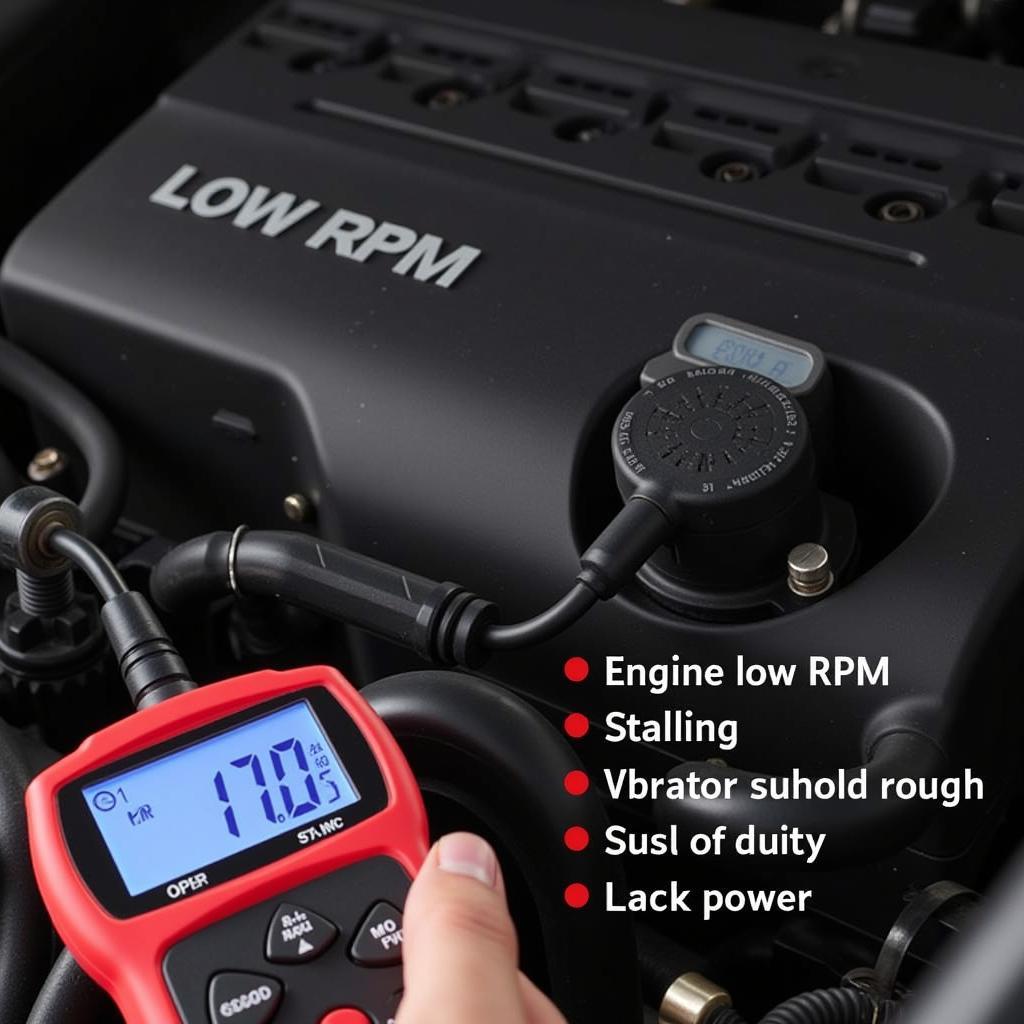A Car Low Rpm Problem can be frustrating and potentially damaging to your engine. This article will help you diagnose and fix the issue, whether you’re a car owner, mechanic, or technician. We’ll explore common causes, troubleshooting steps, and solutions to get your car running smoothly again.
 Car engine experiencing low RPM issues
Car engine experiencing low RPM issues
Understanding the Car Low RPM Problem
Low RPM, or revolutions per minute, indicates that your engine’s crankshaft isn’t spinning as fast as it should. This can manifest in various ways, such as stalling, rough idling, lack of power, and poor fuel economy. While a simple fix might solve the problem, a persistent low RPM issue can point to more serious underlying problems. What’s the problem when car turns off when sitting idle? This is one of the common symptoms of a low RPM problem.
Common Causes of Low RPM
Several factors can contribute to a car low RPM problem. These include:
- Vacuum leaks: A leak in the vacuum system can disrupt the air-fuel mixture, leading to low RPM.
- Dirty or faulty idle air control valve (IACV): The IACV regulates the airflow at idle. A malfunctioning IACV can restrict airflow, causing low RPM.
- Clogged air filter: A restricted air filter can starve the engine of air, resulting in low RPM.
- Faulty mass airflow sensor (MAF): The MAF measures the amount of air entering the engine. A faulty MAF can send incorrect signals to the engine control unit (ECU), causing an incorrect air-fuel mixture and low RPM.
- Fuel system issues: Problems with the fuel pump, fuel filter, or fuel injectors can restrict fuel flow, leading to low RPM.
If your car’s control panel is having problems, it could also indirectly contribute to low RPM issues by providing inaccurate readings. You can read more about it in our article on car control panel problem.
Troubleshooting Car Low RPM Issues
Diagnosing a car low RPM problem requires a systematic approach:
- Check for obvious issues: Inspect the air filter, vacuum hoses, and throttle body for any visible damage or blockages.
- Scan for error codes: Use an OBD-II scanner to check for any diagnostic trouble codes (DTCs) stored in the ECU. These codes can provide valuable clues about the underlying problem.
- Test the IACV: You can test the IACV by disconnecting it and checking for smooth idle.
- Check the fuel pressure: Use a fuel pressure gauge to ensure the fuel pump is delivering adequate pressure.
Car engine racing problems can sometimes be related to low RPM issues, as they can both stem from faulty sensors or other engine components. For more information on engine racing problems, check out our dedicated article.
Solutions for Car Low RPM Problem
Once you’ve identified the cause of the low RPM problem, you can implement the appropriate solution:
- Repair or replace vacuum hoses: Replace any cracked or damaged vacuum hoses.
- Clean or replace the IACV: Clean the IACV with a throttle body cleaner or replace it if necessary.
- Replace the air filter: Replace a clogged or dirty air filter with a new one.
- Replace the MAF sensor: Replace a faulty MAF sensor with a new one.
- Address fuel system issues: Repair or replace any faulty components in the fuel system, such as the fuel pump, fuel filter, or fuel injectors.
“A thorough diagnostic process is essential for accurately pinpointing the root cause of low RPM. Don’t just throw parts at the problem – understand it first.” – John Davis, Automotive Engineer
Car Low RPM Problem: Frequently Asked Questions
Q: What is the normal RPM for a car at idle?
A: Typically, a car idles between 600 and 1000 RPM.
Q: Can a bad battery cause low RPM?
A: While a weak battery might struggle to start the engine, it’s unlikely to directly cause consistently low RPM while the engine is running.
Q: How do I know if my IACV is bad?
A: Symptoms of a bad IACV include rough idling, stalling, and difficulty starting.
Conclusion
A car low RPM problem can be a nuisance, but with a systematic approach to troubleshooting, you can identify the cause and implement the right solution. Remember to start with the basics and progressively move towards more complex diagnoses. If you are dealing with flickering LED lights as well, check out this article: car led lights flickering problem. Rotary engines can also experience unique low RPM issues; explore our article on rotary engine car problems for more information. Don’t hesitate to reach out for help if needed. Contact AutoTipPro at +1 (641) 206-8880 or visit our office at 500 N St Mary’s St, San Antonio, TX 78205, United States. We’re here to help you keep your car running smoothly.





Leave a Reply